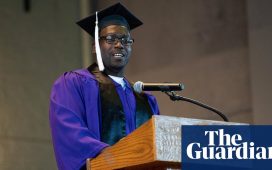The Panelists
Carlos Aramayo is president of the Boston chapter (Local 26) of the union UNITE HERE, which represents 14,000 dining-hall staff members at colleges and universities and other workers in industries including hotels, gaming and food service.
Dr. Michael V. Drake is president of Ohio State University and a physician. He previously served as chancellor of the University of California, Irvine, and vice president for health affairs for the University of California system and was a professor of ophthalmology at the University of California San Francisco School of Medicine.
Mary Dana Hinton is the incoming president of Hollins University in Virginia and emerita president of the College of Saint Benedict in Minnesota. Both are liberal-arts schools.
Richard Levin, an economist, is a former president of Yale University and co-author of a report on gradually reopening higher-education campuses in Connecticut, written for Gov. Ned Lamont.
David Wall Rice is a psychology professor and associate provost at Morehouse College, where he also directs the school’s Identity, Art and Democracy Lab.
Dr. Pardis Sabeti is a biology professor at Harvard University and a member of the Broad Institute and the Howard Hughes Medical Institute. Her work focuses on comprehensive approaches for detecting, containing and treating deadly infectious diseases. Her team was recently awarded funding from the TED Audacious Project to build Sentinel, a pandemic pre-emption and response system.
If Schools Reopen, What Will Campus Life Look Like?
Emily Bazelon: The Cal State system recently announced that its 23 campuses will do most instruction online in the fall. On the other hand, other universities, like Purdue in Indiana and New York University, have said they are inviting students back to campus. Schools like the University of South Carolina have decided to bring students back from August until Thanksgiving and then end the semester online, to avoid a second trip back to campus before the winter holidays. Pardis, what does the science on infectious disease teach about how to minimize risk if students come back to campus?
Pardis Sabeti: With any virus, a big fear is the spread you get when an interwoven community mixes with a larger population — like a college campus in a city. You can try to prevent spread by creating closed circuits with a certain number of individuals. Say up to 10 students live together in a suite or on a hallway and ideally take classes together. They don’t have to social distance from each other as long as if one of them gets infected, everyone in the group quarantines. And they can see other students outside the group if they are careful to social distance, especially outdoors, which is safer.
Some schools, especially small colleges in rural areas, could try to enlarge the closed circuit, perhaps even encompassing the whole campus. This could really only be done if some staff and faculty are within the closed circuit, while others work at a greater distance. The point is to reduce risk as much as possible. Some of that involves testing and asking people to self-report any symptoms, including minor ones. And also, maybe you have mostly teaching fellows or graduate students, rather than older faculty, closely interacting with students. And younger staff who don’t have pre-existing conditions, and who can travel safely, can come to campus.
I think the students most likely care more about being with each other than being with us, when it comes to our physical presence, so there’s some room for exploration there.



